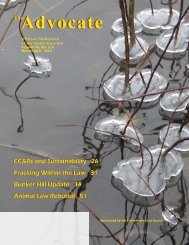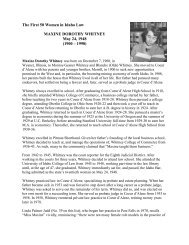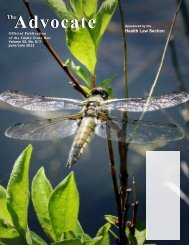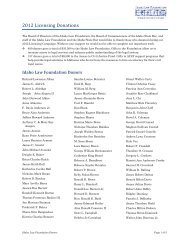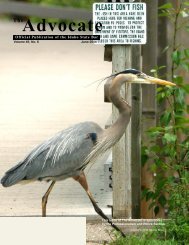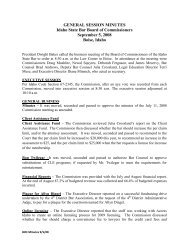The Advocate - May 2012 - Idaho State Bar - Idaho.gov
The Advocate - May 2012 - Idaho State Bar - Idaho.gov
The Advocate - May 2012 - Idaho State Bar - Idaho.gov
You also want an ePaper? Increase the reach of your titles
YUMPU automatically turns print PDFs into web optimized ePapers that Google loves.
Co n j u n C t i o n ju n C t i o n: Ma k i n g Co n j u n C t i o n s fu n C t i o n f o r yo u<br />
Tenielle Fordyce-Ruff<br />
Rainey Law Office<br />
Remember this great song from<br />
Schoolhouse Rock?<br />
Conjunction Junction, what’s your<br />
function?<br />
Hooking up words and phrases and<br />
clauses.<br />
Conjunction Junction, how’s that<br />
function?<br />
I got three favorite cars<br />
That get most of my job done.<br />
Conjunction Junction, what’s their<br />
function?<br />
I got “and,” “but,” and “or,”<br />
<strong>The</strong>y’ll get you pretty far.<br />
While these three conjunctions would<br />
get most school children pretty far, as<br />
legal writers, we need a more nuanced<br />
repertoire to help readers understand our<br />
meaning and how the words, phrases, and<br />
clauses we use relate to each other.<br />
So, to help you better understand how<br />
to make conjunctions function, let’s take<br />
a look at coordinating conjunctions, correlative<br />
conjunctions, and subordinating<br />
conjunctions to connect ideas.<br />
Coordinating conjunctions<br />
<strong>The</strong>se conjunctions are used to join<br />
grammatically equal elements. <strong>The</strong> main<br />
coordinating conjunctions are for, and,<br />
nor, but, or, yet,<br />
so. 1 <strong>The</strong>y coordinate<br />
because<br />
they draw equal<br />
attention to two or<br />
more ideas. You<br />
can use them to<br />
draw attention to<br />
equal words:<br />
<strong>The</strong> speech<br />
was not vulgar, Tenielle Fordyce-Ruff<br />
lewd, obscene, or<br />
plainly offensive.<br />
Or equal phrases (a group of related<br />
words):<br />
<strong>The</strong> <strong>gov</strong>ernment’s actions violate the<br />
establishment clause unless, the <strong>gov</strong>ernment’s<br />
action (i) has a secular legislative<br />
purpose, (ii) does not have the primary<br />
effect of either advancing or inhibiting religion,<br />
and (iii) does not result in an “excessive<br />
<strong>gov</strong>ernment entanglement” with<br />
religion.<br />
Or equal clauses (a group of related<br />
words with both a subject and a verb):<br />
<strong>The</strong> Federal Constitution limits the<br />
<strong>gov</strong>ernment’s ability to abridge free<br />
speech, but the <strong>Idaho</strong> Constitution grants<br />
to every person the right to speak freely.<br />
In additional to creating equal emphasis<br />
on ideas in your sentence, coordinating<br />
conjunctions can be used to add variety to<br />
the length of sentences in a paragraph.<br />
Longer sentences are always useful if you<br />
want to avoid having the reader hear machine<br />
gun fire as he reads your writing.<br />
For instance,<br />
<strong>The</strong> first ten amendments are the Bill<br />
of Rights. <strong>The</strong> First Congress proposed<br />
them to the several states on September<br />
25, 1789. New Jersey ratified them on<br />
November 20, 1789. Virginia ratified<br />
them on November 3, 1791. Connecticut<br />
ratified them on April 19, 1939.<br />
That paragraph is much more pleasant<br />
to read if you add coordinating conjunctions<br />
to vary the length:<br />
<strong>The</strong> first ten amendments are the Bill<br />
of Rights. <strong>The</strong> First Congress proposed<br />
them to the several states on September<br />
25, 1789. New Jersey ratified them on<br />
November 20, 1789, and Virginia ratified<br />
them on December 15, 1791. But, Connecticut<br />
didn’t ratify them until April 19,<br />
1939.<br />
Don’t go too far in the direction of<br />
combining every sentence. Remember,<br />
the occasional short sentence has punch<br />
and demands the reader’s attention.<br />
<strong>The</strong> first Congress proposed the Bill of<br />
Rights to the several states on September<br />
25, 1789. Between November 20, 1789,<br />
and December 15, 1791, eleven of the<br />
states ratified the Bill of Rights. One hundred<br />
forty-eight years later, the last of the<br />
several states ratified the Bill of Rights.<br />
Connecticut takes its time!<br />
Don’t go too far in the<br />
direction of combining<br />
every sentence.<br />
Remember, the<br />
occasional short<br />
sentence has punch and<br />
demands the<br />
reader’s attention.<br />
Correlative conjunctions<br />
Correlative conjunctions are also used<br />
to connect grammatically equal elements,<br />
but these conjunctions come in pairs: either/or,<br />
neither/nor, not only/but also,<br />
whether/or, both/and.<br />
When using correlative conjunctions,<br />
make sure the phrases or clauses you are<br />
connecting are both grammatically equal<br />
(don’t mix and match phrases and clauses).<br />
For example, don’t say:<br />
Wrong: Her speech was either protected<br />
as political speech, or she could<br />
have been making a religious statement.<br />
Correct: She was making either a political<br />
statement or a religious statement.<br />
<strong>The</strong> first sentence is incorrect because<br />
“protected as political speech” does not<br />
have a subject and a verb, so it’s a phrase.<br />
<strong>The</strong> <strong>Advocate</strong> • <strong>May</strong> <strong>2012</strong> 51



